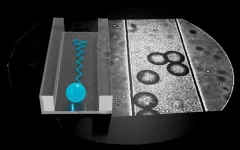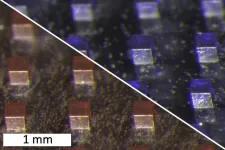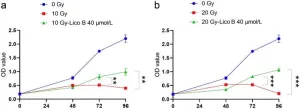(Press-News.org) With growing concern about the ubiquity of toxic chemicals in consumer products, many states have passed laws aimed at protecting people from harmful substances in everyday items like cosmetics, cleaning supplies, plastics, and food packaging. California’s Proposition 65, for instance, is considered one of the most extensive toxics laws in the country.
But does the law work? According to a new study published in the journal Environmental Health Perspectives, it does.
“Not only have people’s exposures to specific toxic chemicals gone down in California, but we also see exposures going down across the country driven in part by Proposition 65,” says lead author Kristin Knox, a research scientist at Silent Spring Institute.
The study’s findings could help inform policies and programs to further curb the use of toxic chemicals in products as well as new research on how regulations and the marketplace influence people’s exposures.
Under Proposition 65, or Prop 65, the state of California maintains a list of more than 850 chemicals known to cause cancer, birth defects, or reproductive harm. Companies that sell products in California are required to warn consumers if their products expose them to harmful amounts of the chemicals.
“We know Prop 65 has helped increase public awareness of risky chemicals and encouraged businesses to reformulate their products with safer ingredients,” says Knox. “But have exposures to toxic chemicals decreased as a result? That’s been a key question.”
Working in collaboration with researchers at the University of California, Berkeley, Knox pulled data from the U.S. National Health and Nutrition Examination Survey (NHANES). Every year, the federal program collects health data from adults and children around the country. The program also collects people’s blood and urine samples and tests them for synthetic chemicals and pollutants.
The researchers analyzed data for 37 biomonitored chemicals through NHANES, including 26 listed under Prop 65 (the remaining 11 were not listed). The analysis showed that, for the majority of the chemicals, levels in people’s bodies went down both in California and nationwide in the years following the chemicals’ listing.
“This aligns with what we’ve learned by interviewing companies,” says Knox. “When companies reformulate their products to avoid Prop 65 chemicals, they end up doing that for all their products, not just those sold in California.”
Exposures to several unlisted chemicals also went down, suggesting other factors at play, the researchers note. For instance, chemicals included in NHANES’ biomonitoring program are chosen because they raise health concerns and therefore may already be subject to pressure from federal regulations, policies, or consumer campaigns that target specific chemicals.
Overall, people in California had a lower body burden than the general population. Levels of 18 of the 37 biomonitored chemicals were lower in California compared with the rest of the U.S. These included diesel-related chemicals, as well as several phthalates, BPA, and PFAS.
The lower levels may reflect increased local press coverage around Prop 65 enforcement and litigation, leading more people in the state to avoid products with harmful ingredients. California’s strict diesel emissions standards likely accounted for the lower exposures to chemicals from diesel exhaust, the researchers note.
“Our finding that Californians are generally less exposed to toxic chemicals than are other Americans has potentially far-reaching implications. It suggests a tangible public health payoff from the state's more stringent environmental regulations,” says co-author Claudia Polsky, Director of the Environmental Law Clinic at UC Berkeley School of Law. “We hope other researchers will probe this issue further so we can better understand which regulations work, and why.”
The study found evidence of companies swapping out one toxic chemical, after its listing under Prop 65, for another problematic chemical with similar chemical structure and health effects. For instance, levels of BPA, which has been used in some plastic bottles, thermal receipt paper, and food can linings, decreased after the chemical was listed in 2013. Meanwhile, levels increased of its unlisted chemical cousin BPS.
Similarly, levels of the phthalate DEHP, used in vinyl and other plastic products, went down after it was listed in 2003. At the same time, exposures to a closely related unlisted phthalate called DiNP went up. Levels of DiNP then dropped after it was also listed in 2013.
The researchers say their findings highlight the need to increase investment in biomonitoring programs to track changes in people’s exposures to toxic chemicals in response to environmental policies. “We have relatively good national-level biomonitoring data, but NHANES isn’t designed to detect changes in chemical exposures driven by local or state-level policy,” says co-author Meg Schwarzman, a physician and environmental health scientist at the UC Berkeley School of Public Health.
“Policymakers could change this picture by better supporting both NHANES and state-level biomonitoring programs, as well as creating chemicals policies that require before-and-after testing to measure the policy’s effectiveness. This could really help identify interventions that actually reduce toxic exposures,” says Schwarzman.
Funding for this project was provided by the California Breast Cancer Research Program (Grant #23QB-1881) and payments that private litigants directed to Silent Spring Institute in lieu of civil penalties in Prop 65 enforcement cases to further the cause of toxics reduction and charitable contributions to Silent Spring Institute.
Reference: Knox, K.E., M.R. Schwarzman, R.A. Rudel, C. Polsky, and R.E. Dodson. 2024. “Trends in NHANES biomonitored exposures in California and the U.S. following enactment of California’s Proposition 65.” Environmental Health Perspectives. 132(10). DOI: 10.1289/EHP13956
About Silent Spring Institute: Silent Spring Institute, located in Newton, Mass., is the leading scientific research organization dedicated to uncovering the link between chemicals in our everyday environments and women's health, with a focus on breast cancer prevention. Founded in 1994, the institute is developing innovative tools to accelerate the transition to safer chemicals, while translating its science into policies that protect health. Visit us at www.silentspring.org.
END
People’s exposure to toxic chemicals declined in the U.S. following listing under California law
First study to evaluate effectiveness of Proposition 65 shows benefits of law extend nationwide
2024-10-29
ELSE PRESS RELEASES FROM THIS DATE:
Trauma, homelessness afflict gender affirming care patients at higher rates
2024-10-29
A survey of patients receiving gender affirming care shows that commercial insurance pays for most of their treatments, they receive less care in the South than other parts of the U.S. and they deal with disproportionate levels of housing insecurity and trauma compared to others, according to a new study by researchers at the Colorado School of Public Health and the University of Colorado Anschutz Medical Campus.
The study, using data provided by Kythera Labs, a healthcare clearinghouse, examined millions of insurance claims by patients undergoing gender affirming care (GA) and those not. It also looked at social determinants of healthcare (SDOH), non-medical factors ...
New $5 million DoE award supports KU startup’s green hydrogen energy research
2024-10-29
LAWRENCE — With $5 million in support from the U.S. Department of Energy, the University of Kansas and Avium — a startup firm founded by researchers from KU’s School of Engineering — aim to make clean hydrogen more affordable.
According to the DoE, the work at KU is part of $750 million in funding for 52 projects across 24 states “to dramatically reduce the cost of clean hydrogen and reinforce American leadership in the growing hydrogen industry.”
Green hydrogen is a key tool in the worldwide ...
A navigation system for microswimmers
2024-10-29
Microswimmers often need to independently navigate narrow environments like microchannels through porous media or blood vessels. The swimmers can be of biological origin, like algae or bacteria, but also constitute custom designed structures used for the transport of chemicals and drugs. In these cases, it is important to control how they swim in relation to walls and boundaries - as one might want them to exchange fuel or information, but also avoid them to stick where they are not supposed to.
Many swimmers are electrically ...
Study finds early TAVR can be beneficial for patients with asymptomatic severe aortic stenosis
2024-10-29
WASHINGTON, DC – OCTOBER 28, 2024 – The first powered randomized trial examining early intervention with transcatheter aortic valve replacement (TAVR) in patients with asymptomatic, severe aortic stenosis (AS) found this strategy to be both a safe and effective alternative to clinical surveillance (CS).
Findings were reported today at TCT 2024, the annual scientific symposium of the Cardiovascular Research Foundation (CRF). TCT is the world’s premier educational meeting specializing in interventional ...
Implantable microparticles can deliver two cancer therapies at once
2024-10-29
Patients with late-stage cancer often have to endure multiple rounds of different types of treatment, which can cause unwanted side effects and may not always help.
In hopes of expanding the treatment options for those patients, MIT researchers have designed tiny particles that can be implanted at a tumor site, where they deliver two types of therapy: heat and chemotherapy.
This approach could avoid the side effects that often occur when chemotherapy is given intravenously, and the synergistic effect of the two therapies ...
Early intervention in patients with asymptomatic severe aortic stenosis and myocardial fibrosis falls short of expected benefits
2024-10-29
WASHINGTON, DC – OCTOBER 28, 2024 – The EVOLVED trial found that early aortic valve intervention in patients with asymptomatic severe aortic stenosis (AS) and mid-wall myocardial fibrosis on magnetic resonance imaging did not reduce the incidence of the composite primary endpoint of all-cause death or unplanned aortic stenosis hospitalization compared with guideline-directed conservative management.
Findings were reported today at TCT 2024, the annual scientific symposium of the Cardiovascular Research Foundation (CRF). TCT is the world’s premier educational meeting specializing in interventional cardiovascular ...
The surprising reason a classical computer beat a quantum computer at its own game
2024-10-29
Earlier this year, researchers at the Flatiron Institute’s Center for Computational Quantum Physics (CCQ) announced that they had successfully used a classical computer and sophisticated mathematical models to thoroughly outperform a quantum computer at a task that some thought only quantum computers could solve.
Now, those researchers have determined why they were able to trounce the quantum computer at its own game. Their answer, presented on October 29 in Physical Review Letters, reveals that the quantum problem they tackled — involving ...
Researchers Aim To Get Leg Up on Bone Repair with 3D-Printed Femur
2024-10-29
University of Texas at Dallas mechanical engineers have designed a 3D-printed femur that could help doctors prepare for surgeries to repair bones and develop treatments for bone tumors.
The engineers, who worked in collaboration with UT Southwestern Medical Center orthopedic surgeons, published their first study on the 3D-printed thigh bone online Aug. 5 in the Journal of Orthopaedic Research.
The study, which focused on the middle section of the bone, establishes 3D-printing parameters for a femur for use in biomechanical testing. Researchers said more studies will be needed before the technology could be available for widespread use.
To study and validate innovative surgical implants ...
Transforming patient care: study finds bedside interdisciplinary rounds boost satisfaction for patients and providers
2024-10-29
A study led by researchers at the University of Colorado Anschutz Medical Campus reveals patients and providers have more positive overall care experiences when the entire healthcare team is a part of bedside interdisciplinary rounds (BIDR).
The study published today in the Journal of General Internal Medicine.
The study found that BIDR, when the team meets at a patients’ bedside in the hospital to discuss care plans, helps build trust between patients and their healthcare providers and within healthcare teams by allowing everyone to observe and work together more closely.
“Traditional ...
Radioprotective effects of licochalcone B: DNA protection, cytokine inhibition, and antioxidant boost
2024-10-29
Background and objectives
Radiation injury poses a serious threat to human health, causing complex and multifaceted damage to cells and tissues. Such injury can be caused by various factors, including nuclear accidents, medical radiation therapy, and space travel. Currently, finding effective treatment methods and drugs to mitigate the harmful effects of radiation injury on the human body is a crucial research direction. This study aimed to explore the protective effects and mechanisms of Licochalcone ...
LAST 30 PRESS RELEASES:
Making lighter work of calculating fluid and heat flow
Normalizing blood sugar can halve heart attack risk
Lowering blood sugar cuts heart attack risk in people with prediabetes
Study links genetic variants to risk of blinding eye disease in premature infants
Non-opioid ‘pain sponge’ therapy halts cartilage degeneration and relieves chronic pain
AI can pick up cultural values by mimicking how kids learn
China’s ecological redlines offer fast track to 30 x 30 global conservation goal
Invisible indoor threats: emerging household contaminants and their growing risks to human health
Adding antibody treatment to chemo boosts outcomes for children with rare cancer
Germline pathogenic variants among women without a history of breast cancer
Tanning beds triple melanoma risk, potentially causing broad DNA damage
Unique bond identified as key to viral infection speed
Indoor tanning makes youthful skin much older on a genetic level
Mouse model sheds new light on the causes and potential solutions to human GI problems linked to muscular dystrophy
The Journal of Nuclear Medicine ahead-of-print tip sheet: December 12, 2025
Smarter tools for peering into the microscopic world
Applications open for funding to conduct research in the Kinsey Institute archives
Global measure underestimates the severity of food insecurity
Child survivors of critical illness are missing out on timely follow up care
Risk-based vs annual breast cancer screening / the WISDOM randomized clinical trial
University of Toronto launches Electric Vehicle Innovation Ontario to accelerate advanced EV technologies and build Canada’s innovation advantage
Early relapse predicts poor outcomes in aggressive blood cancer
American College of Lifestyle Medicine applauds two CMS models aligned with lifestyle medicine practice and reimbursement
Clinical trial finds cannabis use not a barrier to quitting nicotine vaping
Supplemental nutrition assistance program policies and food insecurity
Switching immune cells to “night mode” could limit damage after a heart attack, study suggests
URI-based Global RIghts Project report spotlights continued troubling trends in worldwide inhumane treatment
Neutrophils are less aggressive at night, explaining why nighttime heart attacks cause less damage than daytime events
Menopausal hormone therapy may not pose breast cancer risk for women with BRCA mutations
Mobile health tool may improve quality of life for adolescent and young adult breast cancer survivors
[Press-News.org] People’s exposure to toxic chemicals declined in the U.S. following listing under California lawFirst study to evaluate effectiveness of Proposition 65 shows benefits of law extend nationwide





